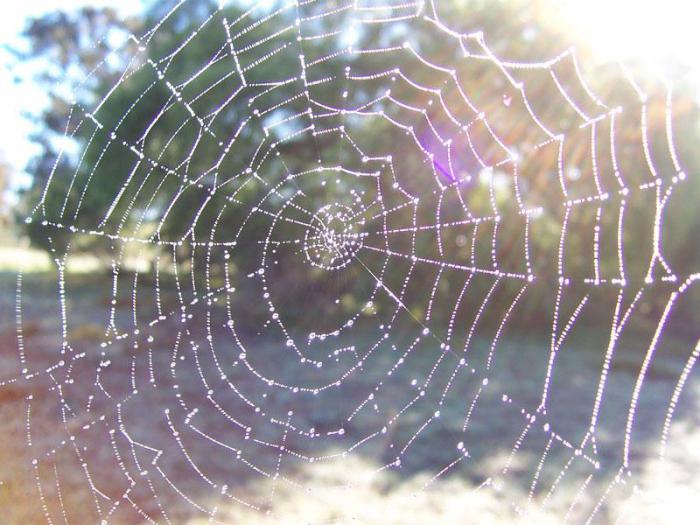What kind of spiders belong to. Encyclopedia
Spiders are the largest arachnids. They are described more than 39 thousand species, and this is not the limit. Scientists continue to find more and more new species of these most interesting arthropods. All land is occupied by spiders. Like insects and mites, they live everywhere, and there is no corner in the nature where spiders do not meet.
Most spiders lead a solitary lifestyle and do not tolerate the neighborhood of individuals of their species (even the opposite sex). Communication between the representatives of different sexes often ends very tragically: the male becomes a dinner for the fertilized female. But there are no rules without exceptions. As research has shown, in the world there are about 20 species of spiders that lead a colonial way of life. They belong to 11 families, living mainly in the tropical regions of North and South America, Africa, Indochina, New Guinea. Some social spiders are known to science quite a long time - from the XIX century. One of such long known to scientists species - south American public spider (Uloborus republicanus). Individuals of this species build a huge single hawking network, and inside this network each female builds another separate net. Here, males live and cocoons are attached with future offspring.
Spiders Stegodyphus mimosarum
In southern Africa live spiders Stegodyphus mimosarum, which build a common sack-like nest and all together hunt its surface.
Even larger in size, the web is woven by spiders Theridion eximium. Thousands of individuals make a common web, which can cover a whole coffee tree.
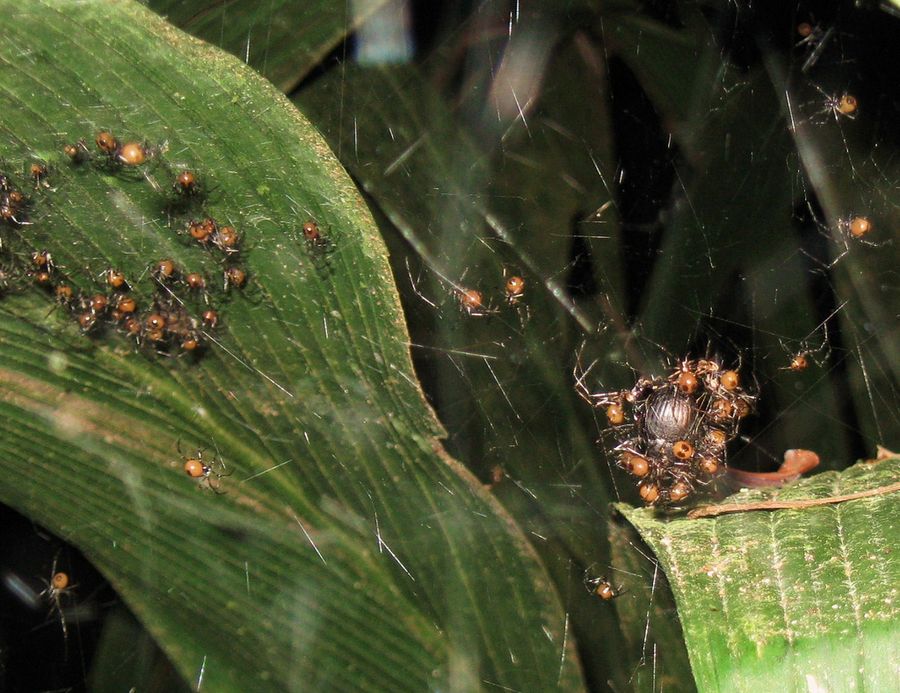
Spiders Theridion nigroannulatum
Letitia Aviles from the University of British Columbia found that spiders of a close kind, Theridion nigroannulatum, who live in Ecuador, also hunt and live together. Described these spiders as early as 1884, biologist Alexander Keyzerling, but then no one paid attention to the peculiarities of their way of life. Studies L. Aviles led her colleagues in astonishment. It turned out that individuals Theridion nigroannulatum not only build a common network, but also cooperate in attacking and eating the victim, i.e. to some extent are "social arachnids".
The network-socket of spiders of this kind envelops the tops of branches of one or several bushes, including leaves. The spiders themselves are hiding from the back side of these leaves, waiting for an imprudent victim to appear. If an insect accidentally touches a thread, then a large group of spiders runs out of the ambush, which together inject a deadly poison into the body of the prey. After this, hunter-spiders place the victim in their colony, where all members of the spider community participate in its eating (more precisely, sucking). It is interesting that if the victim turns out to be too large, the spiders carry it, taking turns replacing each other.
Young individuals and egg cocoons are located in the depth of the nest. Female spiders of this species are of two sizes, and, unlike social insects like bees, they do not have this associated with the division of labor. In bee families, small individuals - working bees are engaged in the search for food, and large uterus - reproduction. Spiders have no such division.
Spider Colonies Theridion nigroannulatum are very diverse in size: sometimes they consist of several dozen individuals, and sometimes - of several thousand. However, large colonies can at times break up into small separate groups. In this spiders are very tolerant not only to individuals from their nests, but, as experiments have shown, and to individuals of the same species from other nests. Such tolerance for the relatives is one of the first conditions for the emergence of sociality. Spiders regularly communicate with each other by touching their paws, apparently exchanging certain informative signals.
Several species of public spiders have been found in the Australian continent. K. Bowden of New Zealand University in Christchurch researched the biology of one of the spitting spiders - Scytodes fusca, inhabiting the north of Australia, in Queensland. This spider family as a whole is characterized by a very unusual feature - they "spit" their prey with a special adhesive liquid, which forms a sort of spider web. And the spider veins on the abdomen of these spiders are poorly developed.
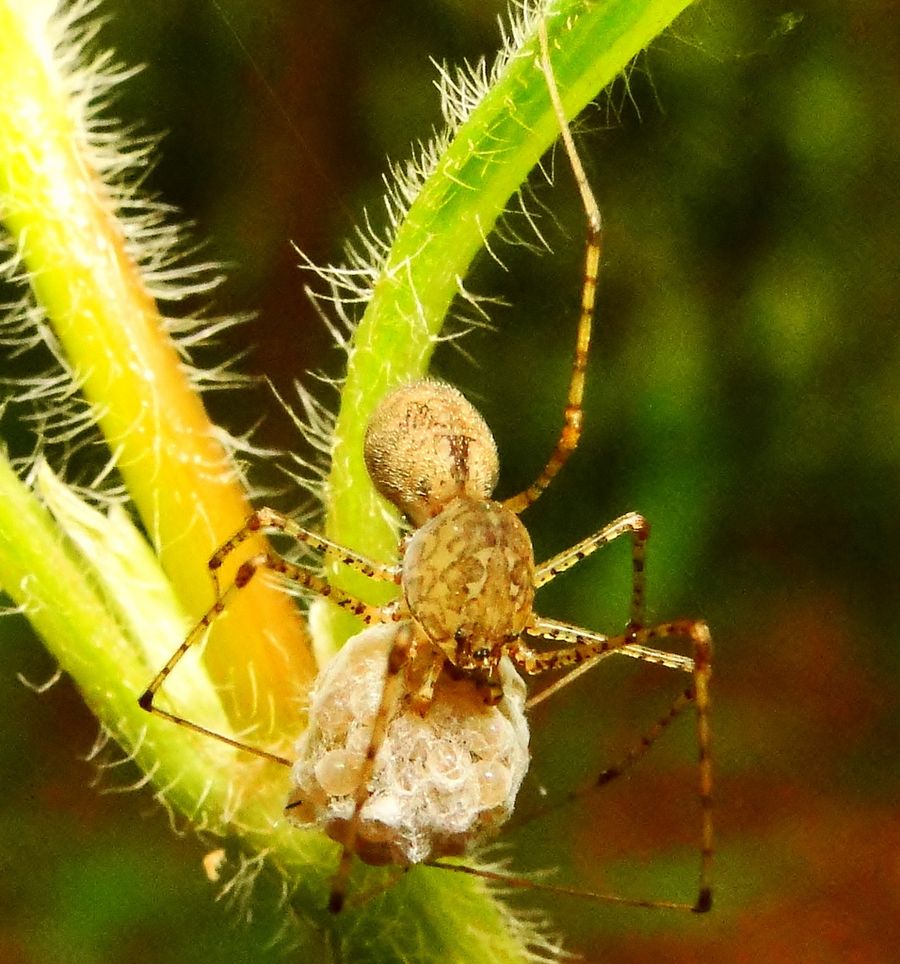
Spider Scytodes fusca
Spitting Spiders Scytodes fusca build entire networked complexes, consisting of separate networks connected by intermediate threads. In each separate nest live up to 50 spiders - usually a female with her young offspring. Males settle on threads connecting nests.
With age, young spiders begin to push each other out of the nest and eventually leave for the other ends of the colony. Adult individuals live on their own and to aliens who are trying to penetrate their territory are very aggressive.
Another species of colonial spiders living in Australia - Badumna socialis from New South Wales. These spiders live in limestone caves, where they settle at the entrance. The vaults of the cave protect the spiders from the weather, and they do not go hungry, because many insects also seek refuge in the cave from unfavorable conditions.
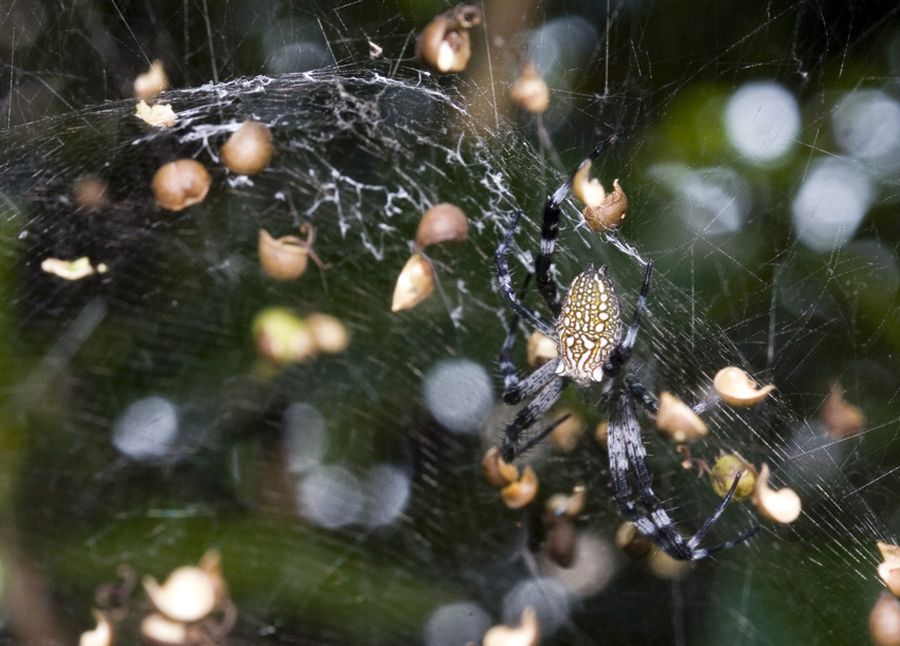
As you can see from the Latin name, individuals Badumna socialis live in groups and, like other social spiders, they build one common web, in which unguarded insects are caught. Each spider weaves its network in the immediate vicinity of the neighbor, so that in the end the web covers a few square meters of the ceiling of the cave.
It should be noted that Badumna socialis - A rare spider. Scientists know only four populations of this species (although quite well-off), found in a relatively small area. At the same time, his closest relative is a black house spider Badumna insignis is quite common in Australian homes, where it weaves its cobwebs on the windows and does not show a propensity for a social way of life. It is possible that u Badumna socialis The desire for cooperation is due to the rather peculiar conditions in which this species lives.
Colonial spiders live not only in warm countries. They can be found, for example, in the territory of Kazakhstan, on the shores of Lake Balkhash. Here lives a small (only 6-8 mm) spider Araneus pallasi. He lives in the bushes surrounding the ponds - this is a typical coastal species that feeds on branchy mosquitoes. Its web is a dense plexus of threads, a continuous mass of braided branches and leaves of bushes. In this dense messy plexus live spiders of different ages. Usually during the day they hide in the inner part of their structure, and at dusk and at night they are selected outside. Here, each spider occupies a tiny hunting territory, to which it aspires not to let its relatives. But, despite the observance of some minimal territoriality, in general Araneus pallasiare very friendly, never attack each other and even being hungry in one bank do not attempt cannibalism.
Small spiders of this species, newly emerged from cocoons, freely move around the public dwelling and even often suck on the prey eaten by large spiders, thus sharing a meal with them. Female before laying eggs also collect in the sun in large groups, and then, at night, fold their cocoons into large common packets, which sometimes can reach the size of a soccer ball! In this cluster of cocoons, located among dense cobwebs, protected in this way from enemies and bad weather, successfully survive the winter and spiders of younger ages, while adult spiders die with the onset of winter. Some of the young spiders, however, leave their native colonies in autumn, flying away with wind on their parachute cobwebs. The more overpopulated the collective dwelling, the stronger at young spiders the desire to "fly apart". Most of them fall into unsuitable places for life and perish. But if the place turned out to be successful, the spider begins to create its own web (typical circular web, typical for all spiders-tempters). Later this place can become a new social dwelling, since most young spiders remain near the mother, who at first takes a very active care of her offspring. In this way, Araneus pallasitwo forms of life are characteristic: in large public settlements and on the position of a typical solitary spider predator.
It is interesting that in the social outlines of this spider, some other species also settle, which also feed on branching mosquitoes. This, for example, larger spiders of the same kind - A. cornutus and A. adiantus. Representatives of these two species are difficult to see in the daytime among a large congestion of individuals of the social spider, since both species are hidden in the inner chambers. And this is not accidental, as birds eat more readily. And only with the onset of twilight they appear on the surface and begin to weave their threads to the public web for hunting.
In public settlements Araneus pallasi you can meet and several other species of spiders. For example, there are sheltered horsemen, flower spiders and some small species of spider-taunts. All of them move on a common web, avoiding meeting each other and not showing aggression either to their masters or to each other. Those. with an abundance of food, "evil" spiders-predators become quite peaceful in relation to each other animals capable of coexistence.
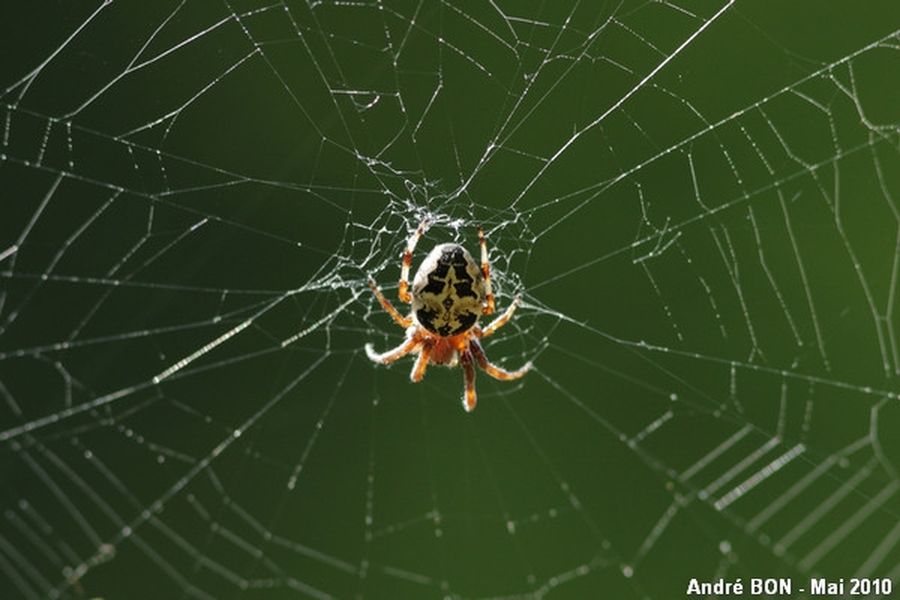
With an abundance of food, even well-known spider-spiders (Araneus folium) proved to be capable of social life.
With an abundance of food, even the well-known spiders-frogs (Araneus folium). Small public settlements of this species were discovered by our researchers in the mid-1990s. in Western Turkmenistan.
Although the propensity for colonialism and cooperation is noted only in 0.1% of the total number of species of spiders, scientists believe that it has arisen repeatedly during the evolution of these arthropods. Two hypotheses of the formation of a social way of life in spiders have been put forward: the subsocial and parasocial. According to the first, sociality developed due to the expansion of care for the offspring. Parasocial path - forced tolerance to each other when the concentration of spiders on some especially feeding places. Perhaps, in different cases, the evolution of social species was either one way or the other way.
SPIDERS(Aranei), a group of arachnids, including mites, scorpions, haymakers, etc. Spiders for a number of signs are close to insects, but clearly differ from them, and these groups are related only by a very distant relationship. A well-known characteristic feature of many spiders is the ability to weave a complexly arranged hawk net (net) from a silk-like substance secreted by the arachnid glands. Some spiders, such as the black weaver spider (black widow) and tropical bird-eaters, can cause very painful bites, which are fraught with a fatal outcome, but most spiders, although biting, are not dangerous to humans.
The name of the class Arachnoidea comes from the Greek. arachne is a spider. In ancient Greek mythology Arachnaya was a girl who was so skilled as a weaver that, summoning the goddess Athena to the very patroness of this craft, she weft a better fabric than she. The disgruntled goddess turned the rival into a spider, announcing that from now on Arachna and all her family will be spinning and weaving until the end of the century.
In total it is known approx. 30 000 species of spiders. The length of their torso is from 0.1 to 5 cm. The main food is the liquid tissues of insects, which spiders catch, rushing from ambush or using cobwebs. Spiders are found on almost all inhabited latitudes and altitude marks: they were found on the slopes of Mount Everest at 6700 m above sea level and caught (juveniles) 600 m from the surface of the earth. Some species live in water. Having settled, the juveniles of a number of small species are taken to the ends of grass and other towering objects and, raising their abdomen, begins to secrete the arachnoid thread, which is picked up by a stream of air and, reaching a sufficient length, carries away the animal. Such years occur in certain seasons and are especially noticeable in the "female summer", when in the air you can see whole "carpets-planes" from dozens of interwoven cobwebs. This unique way of settling allows spiders to cover huge distances and to reach even the islands lost in the ocean.
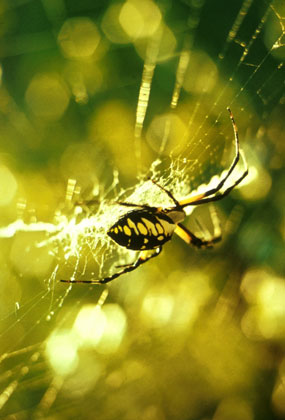
Web and the construction of a net.
The ability to secrete a spider thread is a characteristic feature of almost all spiders. Material for it is formed in the special glands located in the back of the abdomen, and the so-called. arachnoid warts. Some spiders produce threads of different (up to six) types and use each of them for quite specific purposes.
When the spider moves, it continuously allocates a web, which, like a mountaineer, a safety rope, from time to time attaches to the surfaces it passes through. That's why the disturbed spider almost always can, with his legs tucked, fall off the support and, hanging on an extensible thread, descend it to the ground. When the net gets prey, the spider usually flies its web and only then kills with poisonous claws (chelicera) and sucks.
Probably the most interesting feature of spiders is the construction of a network of trapping nets. Their forms are very diverse and often very beautiful. Not all spiders use their web for catching insects, but each species weaves it in a specific way, and the resulting design may well serve as a taxonomic feature. The most beautiful, so-called. wheel-shaped, a spider-circle spiders of the family of cross-arms (Araneidae). First the spider climbs to a high place, usually near a path or other open space, and secrets a very light thread that is picked up by the wind and, accidentally hitting a nearby branch or other support, wraps around it. The spider moves on this thread to a new point, along the way reinforcing the web with an additional secret. In a similar way, another two or three relatively thick "cables" are laid, making up a closed frame, inside which the proper construction will be located. Usually the net is oriented more or less vertically, but some types of spiders build horizontal networks. Between the sides of the frame stretch filaments, radii, connecting in the center, like spokes in the wheel hub. Now, starting near this place, the spider moves to the periphery in a spiral, leaving behind itself a thread attached to the radii, the distance between the turns of which is determined by the swing of its limbs. While the web is not yet sticky, but after reaching the outer frame, the spider is again spiraling, but with denser spirals, it returns to the center, this time forming a thread, which, unlike the previous ones, is covered with droplets of sticky secretion. As this helix is actually laid, the thread of the first non-stick spiral is bitten and discarded. Obviously, it served only as a kind of construction forest.
When the net is ready, the spider moves to their center or to a nearby shelter and waits for a flying insect to stick to the web. Usually the whole structure works one night, and by the morning it is in many places torn.
One of the most beautiful networks wavers the usual look Argiope aurantia, a large spider with a black and golden pattern on the body. For its extensive spiked tent, a zigzag filament that runs vertically through the center of the structure is characteristic. The form of the trapping network of other species is completely different. For example, in representatives of the genus Frontinella it resembles a cup on a saucer. In funnel spiders (the Agelenidae family) the net is similar to the net, and spiders of the Gnaphosidae family build tubular shelters from the web under rocks and other objects, where they hide between the outlets for hunting. An unusual wheel-like network of golden threads builds a view Nephila clavipes. For this large spider, common in the southern United States, are characterized by legs with tufts of hairs.
The ability of spiders to secrete a silk-like thread repeatedly led to attempts to use them like silkworms, but these experiments had no success. The main difficulty is that spiders need to be fed live insects, and for a fairly quick one kilogram of fiber requires more than 1.3 million spiders! At one time cobwebs were made by crosshairs of optical instruments, for example theodolites, leveling and telescopes.
Many spiders do not build networks at all and just hunt prey from ambush. This is typical of representatives of such families as spiders-wolves (Lycosidae), spiders-horses (Salticidae) and ptichaeids-terafosides (Theraphosidae). Spiders-horses, for example, track down victims, using sharp sight, and overtake them with one jump.
Spiders, detachment of arthropod animals of class arachnids . The sizes from 0,7 mmup to 11 cm; coloration is very diverse. The body consists of the cephalothorax and abdomen, connected by a short stalk. The cephalothorax is covered with a dorsal shield, usually 8 eyes on the anterior margin. Finishes 6 pairs; first pair - clawlike chelicera (on their claws the ducts of poisonous glands open); the second - of the tentacle, or pedipalps (in males, their terminal segments are turned into copulatory organs); The remaining 4 pairs are walking legs ending with claws. The abdomen, as a rule, is not dissected; only a few, the most primitive (arthropods), it consists of 11 segments. In the anterior part of the abdomen, there are holes of the anterior pair of lungs from below, and a few behind - openings of the second pair (four-lungs) or spiracles of trachea (two-lungs); on the back of the abdomen from 1 to 4 pairs of cobweb warts - modified abdominal legs; on the top of the warts open numerous ducts spider glands . All P. (except water spider ) live on land in a variety of habitats. P.- night animals, only a few are active during the day. Along with mobile, running P., who do not build permanent nests and shelters, there are inactive, inhabiting tents or in mink and lairs. P. have touch, sight, smell, hearing, are able to perceive the vibration and tension of the threads of the web; P.'s eyes, as a rule, are able to distinguish only the sizes of objects and their movement. All P. are predators; feed mainly on insects. The captured prey is covered with cobwebs; on killed and usually mashed by chelicera prey, they spew out the digestive juice, which quickly dilutes its tissues. Liquid food with a special suckling stomach is sent to the intestines. P. Dividers; Males are often much smaller than females. Before mating the male plaits a small cobweb spider, on which a small droplet of seed separates; then he substitutes the legs of the paws bent under the hammock with copulatory organs and fills them with a seeping seed. Eggs are usually deposited in cobweb cocoons, which many animals carry with them or guard before the release of young spiders. The detachment unites about 21 thousand species; in the USSR about 2 thousand species. P. divided into 3 suborders: arthropods P. (Liphistiomorphae), P.-tarantulas (Mygalomorphae) and two-lung P. (Aga neomorphae). The first two suborders are all four-legged P. The vast majority of P., including the house P. (Tegenaria derhami), water P., cross , tarantula , karakurt and others, belongs to the suborder of two-pulmonary. Many P. exterminate harmful insects; cotton aphid, harmful turtle, malarial mosquitoes and others. Some, mainly tropical, P. are poisonous and dangerous to pets and humans. Among the fauna of the USSR, the South Russian tarantula and especially the Karakurt are poisonous.



